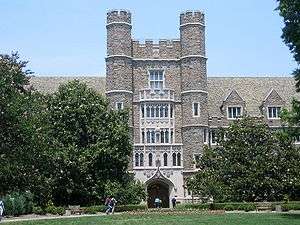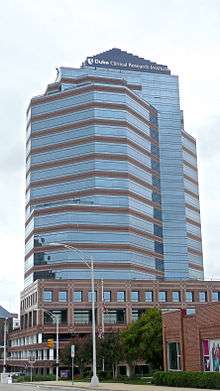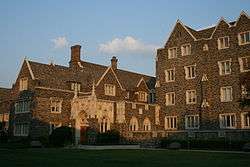Duke University School of Medicine
|
| |
| Type | Private |
|---|---|
| Established | 1930 |
Parent institution | Duke University |
| Dean | Nancy Andrews |
Academic staff | 2,000+ |
| Students | 450 |
| Location |
Durham, North Carolina, United States 36°00′03″N 78°56′25″W / 36.0007°N 78.9403°WCoordinates: 36°00′03″N 78°56′25″W / 36.0007°N 78.9403°W |
| Campus | Urban |
| Website |
medschool |
The Duke University School of Medicine (Duke Med) is Duke University's medical school operating under the auspices of the Duke University Medical Center. Established in 1925 by James B. Duke, Duke Med has earned its reputation as an integral part of one of the world's foremost patient care and biomedical research institutions.
Clinical rotations by medical students and residents occur within the Duke University Health System, a fully integrated academic health care system encompassing a tertiary-care hospital and specialty clinics on the Medical Center campus, two community hospitals, home health and hospice services, a network of primary care physicians, and other affiliated partners across the SE United States. In particular, Duke University Medical Center is consistently ranked among the top 10 of some 5,700 American hospitals by US News and World Report, with 13 out of 16 specialties ranked among the nation's top 20 in 2007. Furthermore, the School of Medicine is especially noted for its groundbreaking biomedical research, bringing in $407 million in NIH-sponsored projects in 2006.
History

In 1925, James B. Duke made a bequest to establish the Duke School of Medicine, Duke School of Nursing, and Duke Hospital, with the goal of improving health care in the Carolinas and nationwide. 3,000 applicants applied to the new medical school in 1929 and 70 first- and third-year students were selected, including four women, for the School's inaugural class. In 1935, just five years after it opened, Duke was ranked among the top 25 percent of medical schools in the country by the AAMC.
In 1966, The Duke Medical Scientist Training Program (MSTP), a joint degree program leading to both the MD and the PhD degrees, was founded. The $94.5 million, 616-bed Duke Hospital opened in 1980, bringing the total number of patient beds to more than 1000. (Today the renovated original hospital serves as Duke Clinic, an outpatient facility that sees more than 1 million patients annually. Duke Hospital is currently licensed for 1,124 beds.) From then until 1994, the Medical Center embarked on the busiest period of new construction in decades, including the Levine Science Research Center, Medical Sciences Research Building, a complete renovation of Duke Clinic, additions to the Morris Building for cancer care and research, a new Children's Health Center, a new ambulatory care building, and new parking garages. Among its many breakthroughs and discoveries in medicine, the FDA approved lifesaving treatment for Pompe disease, a previously fatal genetic disorder, developed at Duke in 2006. That same year, Duke launched the university-wide Global Health Institute to promote education, research, and service in health care to underserved populations.
Rankings and admissions
According to US News and World Report, the Duke University School of Medicine consistently ranks in the top ten medical schools in the United States.[1] Admission to Duke Med is highly competitive, with roughly 3.5% of applicants accepted for the 2015 starting class (7165 applied, 750 interviewed, 253 accepted, for a final class size of 115). The 2015 matriculants had an average GPA of 3.82 and average MCAT of 36. These students consisted of 60 men and 55 women representing 31 states and 51 undergraduate institutions.[2]
Collaboration with the National University of Singapore
Duke opened a medical school collaboration with the National University of Singapore. The Duke-NUS Graduate Medical School graduated their first class in 2011.[3] The curriculum is similar in structure though the Duke-NUS campus focuses heavily on their team-based learning method called TeamLEAD (Learn, Engage, Apply, Develop).[4]
Affiliated research institutions


- The Duke Clinical Research Institute (DCRI) performs all aspects of clinical research ranging from: Phase I through Phase IV clinical trials; outcomes research; registries of more than 100,000 patients; clinical research networks such as the Pediatric Trials Network; and economic and quality of life studies in populations spanning more than 20 therapeutic areas.[5][6] It is home to the Duke Databank for Cardiovascular Diseases, the largest and oldest institutional cardiovascular database in the world, which continues to inform clinical decision-making 40 years after its founding.[7]
- The Duke Global Health Institute (DGHI)' works to reduce health disparities in the local community and worldwide. It brings together interdisciplinary teams to solve complex health problems and to train the next generation of global health scholars. The institute works with faculty and students from every school at Duke. It coordinates educational programs for undergraduate, graduate and professional students and facilitates multi-disciplinary education, research and service efforts on campus and in a variety of international sites.
- The Trent Center for Bioethics, Humanities, and History of Medicine, the Center for Chemical Biology, and the Institute for Genome Sciences & Policy.
- Sarah W. Stedman Nutrition and Metabolism Center. Research efforts include translating basic science and epidemiological findings into well-designed clinical trials, ultimately leading to the development of new therapies for diseases with a metabolic basis such as obesity, diabetes, heart disease, and cancer.
- The Duke Human Vaccine Institute (DHVI) is a national and international leader in the fight against the major infectious diseases. Institute leaders head the $45-million Southeast Regional Center of Excellence for Emerging Infections and Biodefense (SERCEB), established by the NIH and U.S. Department of Health and Human Services in 2003 to perform the basic and translational research to make drugs, vaccines, and diagnostics to protect society from emerging infections and biothreats.
- The Duke Cancer Institute is known for designing innovative therapies using bone marrow transplantation and hyperthermia therapy, for its studies of the immune responses to tumors, and for its treatment of brain tumors, melanoma, lung cancer, breast cancer, ovarian cancer, and prostate cancer.
- The Duke Heart Center has conducted many of the leading studies on the genetic factors underlying heart disease and early trials of new treatments for heart disease, as well as a long-term federal project to define appropriate treatment for heart attack patients.
- The Duke Center for the Study of Aging and Human Development is conducting one of the nation's largest studies of the elderly, surveying over 4,000 people annually to identify risk factors that lead to chronic disease and loss of independence.
- Duke Integrative Medicine is a pioneer in the attempt to examine and quantify the value of mind-body-spirit interventions for the treatment of chronic heart failure.[8]
Notable faculty and alumni
- David H. Adams, heart valve surgery and mitral valve repair
- Raymond Delacy Adams, neurologist and Fellow of the American Academy of Arts and Sciences
- Lenox Baker, physician, public servant
- Charles E. Brady Jr., astronaut
- Julie Story Byerley Pediatrician and Vice Dean for Education for the University of North Carolina at Chapel Hill School of Medicine[9]
- Robert Califf, deputy commissioner at the Food and Drug Administration
- Irwin Fridovich, biochemist who discovered superoxide dismutase
- Philip Handler, biochemist and twice President of the National Academy of Sciences
- Abigail Johnston, Olympic silver medalist in diving, competed in 2012 games as a Duke undergraduate and 2016 games while a medical student at Duke
- John G. Kelton, hematologist and Dean of the McMaster University Medical School and McMaster Faculty of Health Sciences, developed a diagnostic test for heparin-induced thrombocytopenia
- Samuel Katz, developer of measles vaccine and recipient of the Albert B. Sabin Gold Medal
- Robert Lefkowitz, physician and biochemist who received the National Medal of Science and the 2012 Nobel Prize in Chemistry
- Sarah Lisanby, Transcranial magnetic stimulation pioneer and Chair of the School's Department of Psychiatry and Behavioral Sciences
- Paul Modrich, biochemist and member of the National Academy of Sciences who received the 2015 Nobel Prize in Chemistry
- Ron Paul, physician (OB/GYN), United States Congressman from Texas
- Rand Paul, surgeon (ophthalmologist), United States Senator from Kentucky and candidate for the United States Presidential election in 2016
- Jane S. Richardson, biochemist and innovator of ribbon drawings as well as winner of MacArthur Award
- Peter Agre, physician and molecular biologist who received the 2003 Nobel Prize in Chemistry
- Brian Kobilka, physician and biochemist who received the 2012 Nobel Prize in Chemistry
References
- ↑ http://grad-schools.usnews.rankingsandreviews.com/best-graduate-schools/top-medical-schools/research-rankings
- ↑ http://medschool.duke.edu/files/documents/2013-Facts-and-Figures-low-res.pdf
- ↑ Kamei, Cook; Puthucheary, Starmer (2012). "21st Century Learning in Medicine: Traditional Teaching versus Team-Based Teaching". Medical Science Educator. 22 (2). Retrieved 2013-08-01.
- ↑ staff. "AAMC Readiness for Reform: Duke – National University of Singapore Case Study Implementing Team-Based Learning for Medical Students" (PDF). Association of American Medical Colleges. Retrieved 2013-08-01.
- ↑ Duke Medicine. "Research". Duke School of Medicine. Retrieved 3 February 2014.
- ↑ Duke Clinical Research Institute. "DCRI Stats". Retrieved 3 February 2014.
- ↑ Duke Center for Health Informatics. "Duke Databank for Cardiovascular Disease" (PDF). Retrieved 3 February 2014.
- ↑ Eisenberg, Seth. "Studies Offer Insights into Value, Principles of Evidence-Based Relationship Skills Training," Fatherhood Channel, January 20, 2013.
- ↑ "Byerley appointed Vice Dean for Education". Vital Signs. UNC Health Care News. 2013-09-12. Retrieved 2015-04-13.
